A Multi-Cell Hybrid Approach to Elevate the Energy Absorption of Micro-Lattice Materials
Abstract
1. Introduction
2. Materials and Methods
2.1. Material Design Principle
2.1.1. Octet Truss Structure
2.1.2. BCC-Based Structure
2.1.3. Hybrid Design
2.2. Numerical Simulation Procedure
2.2.1. Finite Element Model of the Micro-Lattice Structure
2.2.2. Validation of the Numerical Model
3. Results
4. Discussion
4.1. Mechanism of Stress Elevation
4.2. Energy Absorption of the Hybrid Lattice Structures
5. Conclusions
- (1)
- The multi-cell hybrid method can be adopted to tailor the mechanical behavior of micro-lattice materials. Compared with the pure BCC micro-lattice material, the addition of octet cells results in the higher elastic modulus, initial collapse strengths, and plateau stresses of the hybrid micro-lattice structures.
- (2)
- With the volume fraction of octet cells increases, the elastic modulus of the hybrid lattices increase linearly. The elastic modulus of the multi-cell hybrid lattices are closer to the Hashin–Strikman upper bound.
- (3)
- As the strength of the octet cells is much higher than the BCC cells, the initial collapse strength of the hybrid lattice increases gradually with the volume fraction of octet cells increases. Obvious strain hardening phenomena can be observed in the plateau stress stage of the hybrid lattices as the existence of the octet cell phase is the barrier to deformation.
- (4)
- Resulting from the strain hardening in plateau stress, the energy absorption ability of the hybrid lattice is significantly improved compared with the pure BCC micro-lattice materials. The amplification of the maximum energy absorption can reach 162.6% for the steel lattice and 131.5% for the Ti-6Al-4V lattice when the volume fraction of octet cell is elevated to 13.6%.
- (5)
- The effect caused by the distribution mode of octet cell reinforcements on the mechanical behavior of hybrid lattices is also detected. It is concluded that the symmetric distribution of octet cells will lead to significant stress fluctuations in the plateau stage, which is absent in the lattices with stochastic reinforcements. Nevertheless, the maximum energy absorption is hardly influenced by the distribution mode of the octet cells.
- (6)
- Another interesting phenomenon is observed that when the octet cells are symmetrically distributed in the BCC lattice matrix with a volume fraction of 0.136, the hybrid lattice exhibits a ‘negative Poisson’s ratio’ deformation mode with high energy absorption capacity. This type of structure will be further investigated in the subsequent research due to its potential in defending technology.
Author Contributions
Funding
Conflicts of Interest
References
- Deshpande, V.S.; Ashby, M.F.; Fleck, N.A. Foam topology: Bending versus stretching dominated architectures. Acta Mater. 2001. [Google Scholar] [CrossRef]
- Ashby, M.F. The properties of foams and lattices. Philos. Trans. R. Soc. A Math. Phys. Eng. Sci. 2006. [Google Scholar] [CrossRef]
- Evans, A.G.; Hutchinson, J.W.; Fleck, N.A.; Ashby, M.F.; Wadley, H.N.G. The topological design of multifunctional cellular metals. Prog. Mater. Sci. 2001. [Google Scholar] [CrossRef]
- Xiong, J.; Mines, R.; Ghosh, R.; Vaziri, A.; Ma, L.; Ohrndorf, A.; Christ, H.J.; Wu, L. Advanced Micro-Lattice Materials. Adv. Eng. Mater. 2015. [Google Scholar] [CrossRef]
- Schaedler, T.A.; Jacobsen, A.J.; Torrents, A.; Sorensen, A.E.; Lian, J.; Greer, J.R.; Valdevit, L.; Carter, W.B. Ultralight metallic microlattices. Science 2011. [Google Scholar] [CrossRef]
- Zheng, X.; Lee, H.; Weisgraber, T.H.; Shusteff, M.; DeOtte, J.; Duoss, E.B.; Kuntz, J.D.; Biener, M.M.; Ge, Q.; Jackson, J.A.; et al. Ultralight, ultrastiff mechanical metamaterials. Science 2014. [Google Scholar] [CrossRef] [PubMed]
- Gümrük, R.; Mines, R.A.W. Compressive behaviour of stainless steel micro-lattice structures. Int. J. Mech. Sci. 2013. [Google Scholar] [CrossRef]
- Tancogne-Dejean, T.; Mohr, D. Stiffness and specific energy absorption of additively-manufactured metallic BCC metamaterials composed of tapered beams. Int. J. Mech. Sci. 2018. [Google Scholar] [CrossRef]
- Xiao, L.; Song, W.; Wang, C.; Liu, H.; Tang, H.; Wang, J. Mechanical behavior of open-cell rhombic dodecahedron Ti-6Al-4V lattice structure. Mater. Sci. Eng. A 2015. [Google Scholar] [CrossRef]
- Xiao, L.; Song, W.; Wang, C.; Tang, H.; Fan, Q.; Liu, N.; Wang, J. Mechanical properties of open-cell rhombic dodecahedron titanium alloy lattice structure manufactured using electron beam melting under dynamic loading. Int. J. Impact Eng. 2017. [Google Scholar] [CrossRef]
- Li, X.; Xiao, L.; Song, W. Deformation and failure modes of Ti-6Al-4V lattice-walled tubes under uniaxial compression. Int. J. Impact Eng. 2019. [Google Scholar] [CrossRef]
- Ahmadi, S.M.; Yavari, S.A.; Wauthle, R.; Pouran, B.; Schrooten, J.; Weinans, H.; Zadpoor, A.A. Additively manufactured open-cell porous biomaterials made from six different space-filling unit cells: The mechanical and morphological properties. Materials 2015, 8, 1871–1896. [Google Scholar] [CrossRef]
- Genovese, K.; Leeflang, S.; Zadpoor, A.A. Microscopic full-field three-dimensional strain measurement during the mechanical testing of additively manufactured porous biomaterials. J. Mech. Behav. Biomed. Mater. 2017. [Google Scholar] [CrossRef] [PubMed]
- Hedayati, R.; Sadighi, M.; Mohammadi-Aghdam, M.; Zadpoor, A.A. Mechanical behavior of additively manufactured porous biomaterials made from truncated cuboctahedron unit cells. Int. J. Mech. Sci. 2016. [Google Scholar] [CrossRef]
- Deshpande, V.S.; Fleck, N.A.; Ashby, M.F. Effective properties of the octet-truss lattice material. J. Mech. Phys. Solids 2001. [Google Scholar] [CrossRef]
- He, Z.Z.; Wang, F.C.; Zhu, Y.B.; Wu, H.A.; Park, H.S. Mechanical properties of copper octet-truss nanolattices. J. Mech. Phys. Solids 2017. [Google Scholar] [CrossRef]
- Bagheri, A.; Buj-Corral, I.; Ferrer, M.; Pastor, M.M.; Roure, F. Determination of the elasticity modulus of 3D printed octet-truss structures for use in porous prosthesis implants. Materials 2018, 11, 2420. [Google Scholar] [CrossRef] [PubMed]
- Tancogne-Dejean, T.; Spierings, A.B.; Mohr, D. Additively-manufactured metallic micro-lattice materials for high specific energy absorption under static and dynamic loading. Acta Mater. 2016. [Google Scholar] [CrossRef]
- Li, Z.; Pradeep, K.G.; Deng, Y.; Raabe, D.; Tasan, C.C. Metastable high-entropy dual-phase alloys overcome the strength-ductility trade-off. Nature 2016. [Google Scholar] [CrossRef]
- Song, W.; Ning, J.; Mao, X.; Tang, H. A modified Johnson–Cook model for titanium matrix composites reinforced with titanium carbide particles at elevated temperatures. Mater. Sci. Eng. A 2013. [Google Scholar] [CrossRef]
- Xiang, J.F.; Xie, L.J.; Gao, F.N.; Zhang, Y.; Yi, J.; Wang, T.; Pang, S.Q.; Wang, X.B. On multi-objective based constitutive modelling methodology and numerical validation in small-hole drilling of Al6063/SiCp composites. Materials 2018, 11, 97. [Google Scholar] [CrossRef] [PubMed]
- Xiao, L.; Song, W. Additively-manufactured functionally graded Ti-6Al-4V lattice structures with high strength under static and dynamic loading: Experiments. Int. J. Impact Eng. 2018. [Google Scholar] [CrossRef]
- Mirzaali, M.J.; Hedayati, R.; Vena, P.; Vergani, L.; Strano, M.; Zadpoor, A.A. Rational design of soft mechanical metamaterials: Independent tailoring of elastic properties with randomness. Appl. Phys. Lett. 2017. [Google Scholar] [CrossRef]
- Mirzaali, M.J.; Caracciolo, A.; Pahlavani, H.; Janbaz, S.; Vergani, L.; Zadpoor, A.A. Multi-material 3D printed mechanical metamaterials: Rational design of elastic properties through spatial distribution of hard and soft phases. Appl. Phys. Lett. 2018. [Google Scholar] [CrossRef]
- Maskery, I.; Aremu, A.O.; Parry, L.; Wildman, R.D.; Tuck, C.J.; Ashcroft, I.A. Effective design and simulation of surface-based lattice structures featuring volume fraction and cell type grading. Mater. Des. 2018. [Google Scholar] [CrossRef]
- Momeni, K.; Mofidian, S.M.M.; Bardaweel, H. Systematic design of high-strength multicomponent metamaterials. Mater. Des. 2019. [Google Scholar] [CrossRef]
- Al-Ketan, O.; Lee, D.W.; Rowshan, R.; Abu Al-Rub, R.K. Functionally graded and multi-morphology sheet TPMS lattices: Design, manufacturing, and mechanical properties. J. Mech. Behav. Biomed. Mater. 2020. [Google Scholar] [CrossRef]
- Kang, D.; Park, S.; Son, Y.; Yeon, S.; Kim, S.H.; Kim, I. Multi-lattice inner structures for high-strength and light-weight in metal selective laser melting process. Mater. Des. 2019. [Google Scholar] [CrossRef]
- Pham, M.S.; Liu, C.; Todd, I.; Lertthanasarn, J. Damage-tolerant architected materials inspired by crystal microstructure. Nature 2019. [Google Scholar] [CrossRef]
- Alberdi, R.; Dingreville, R.; Robbins, J.; Walsh, T.; White, B.C.; Jared, B.; Boyce, B.L. Multi-morphology lattices lead to improved plastic energy absorption. Mater. Des. 2020. [Google Scholar] [CrossRef]
- Sha, Y.; Jiani, L.; Haoyu, C.; Ritchie, R.O.; Jun, X. Design and strengthening mechanisms in hierarchical architected materials processed using additive manufacturing. Int. J. Mech. Sci. 2018. [Google Scholar] [CrossRef]
- Ushijima, K.; Cantwell, W.J.; Chen, D.H. Prediction of the mechanical properties of micro-lattice structures subjected to multi-axial loading. Int. J. Mech. Sci. 2013. [Google Scholar] [CrossRef]
- Zhang, M.; Yang, Z.; Lu, Z.; Liao, B.; He, X. Effective elastic properties and initial yield surfaces of two 3D lattice structures. Int. J. Mech. Sci. 2018. [Google Scholar] [CrossRef]
- Li, P. Constitutive and failure behaviour in selective laser melted stainless steel for microlattice structures. Mater. Sci. Eng. A 2015. [Google Scholar] [CrossRef]
- Tancogne-Dejean, T.; Roth, C.C.; Woy, U.; Mohr, D. Probabilistic fracture of Ti-6Al-4V made through additive layer manufacturing. Int. J. Plast. 2016. [Google Scholar] [CrossRef]
- Wang, Z.; Li, P. Characterisation and constitutive model of tensile properties of selective laser melted Ti-6Al-4V struts for microlattice structures. Mater. Sci. Eng. A 2018. [Google Scholar] [CrossRef]
- Xiao, L.; Song, W.; Hu, M.; Li, P. Compressive properties and micro-structural characteristics of Ti–6Al–4V fabricated by electron beam melting and selective laser melting. Mater. Sci. Eng. A 2019. [Google Scholar] [CrossRef]
- Yang, C.; Li, Q.M. Advanced lattice material with high energy absorption based on topology optimisation. Mech. Mater. 2020. [Google Scholar] [CrossRef]
- Seetoh, I.; Markandan, K.; Lai, C.Q. Effect of reinforcement bending on the elastic properties of interpenetrating phase composites. Mech. Mater. 2019. [Google Scholar] [CrossRef]
- Hashin, Z.; Shtrikman, S. A variational approach to the theory of the elastic behaviour of multiphase materials. J. Mech. Phys. Solids 1963. [Google Scholar] [CrossRef]
- Sun, F.B.; Huang, L.J.; Zhang, R.; Wang, S.; Jiang, S.; Sun, Y.; An, Q.; Jiao, Y.; Gen, L. In-situ synthesis and superhigh modulus of network structured TiC/Ti composites based on diamond-Ti system. J. Alloy. Compd. 2020. [Google Scholar] [CrossRef]
- Peng, H.X.; Fan, Z.; Evans, J.R.G. Bi-continuous metal matrix composites. Mater. Sci. Eng. A 2001. [Google Scholar] [CrossRef]
- Song, W.; Dai, L.; Xiao, L.; Wang, C.; Mao, X.; Tang, H. A Meso-Mechanical constitutive model of particle-reinforced titanium matrix composites at high temperatures. Metals 2017, 7, 15. [Google Scholar] [CrossRef]
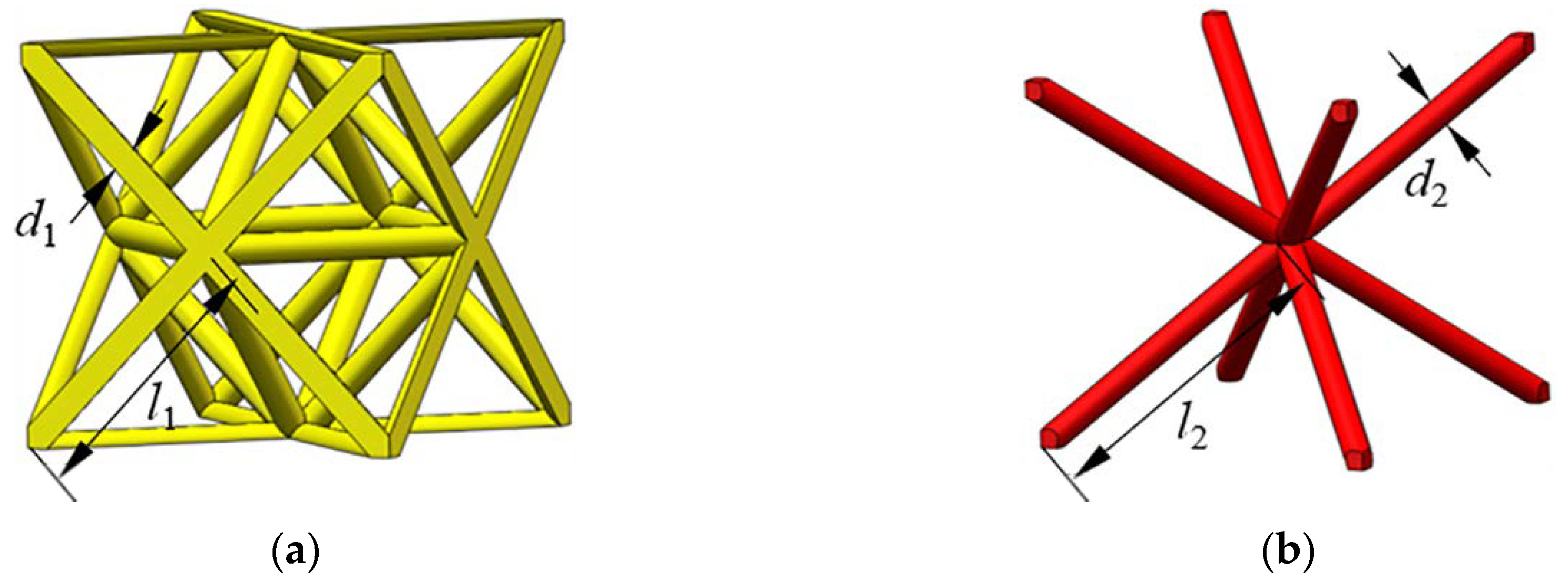

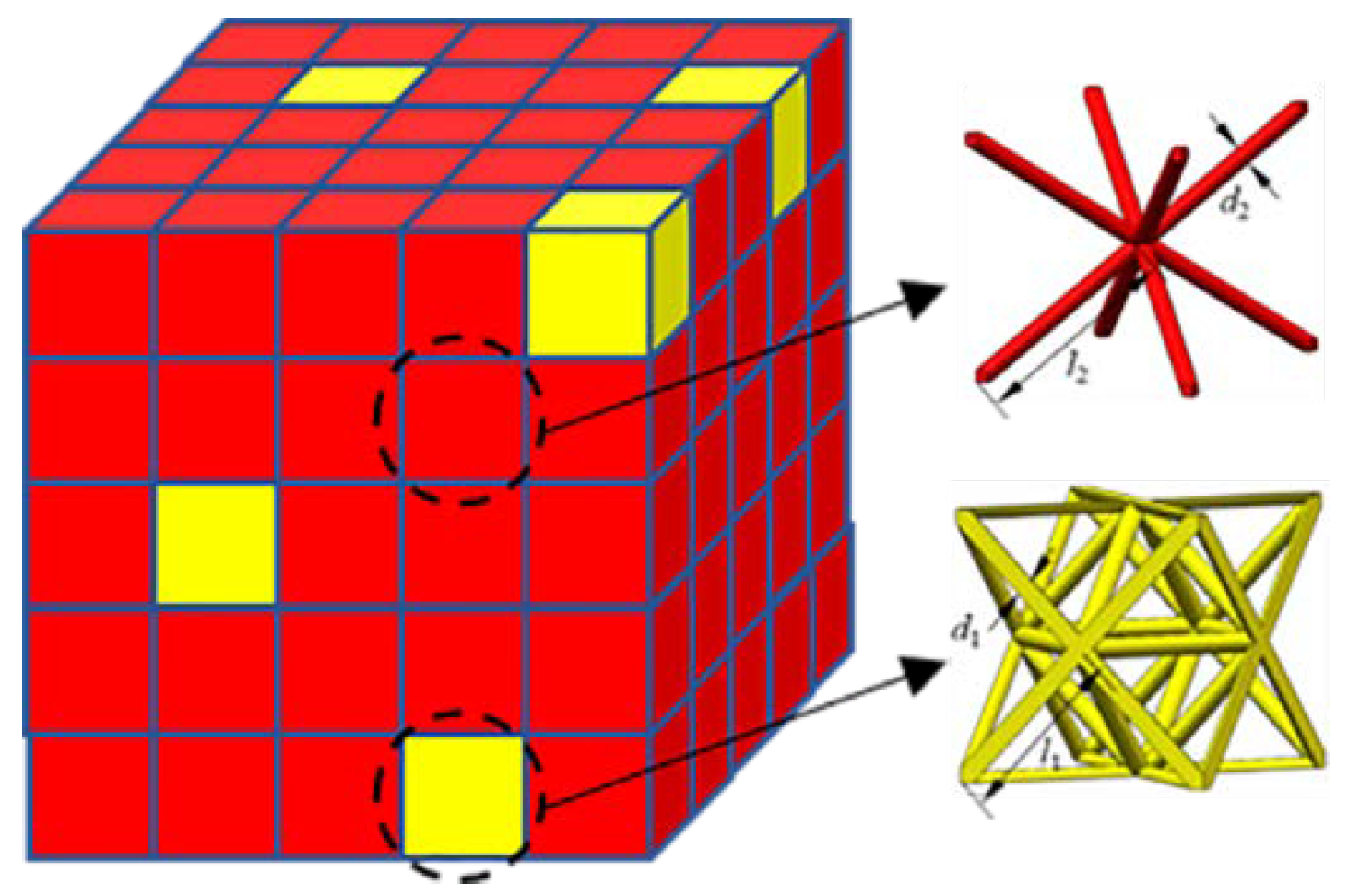
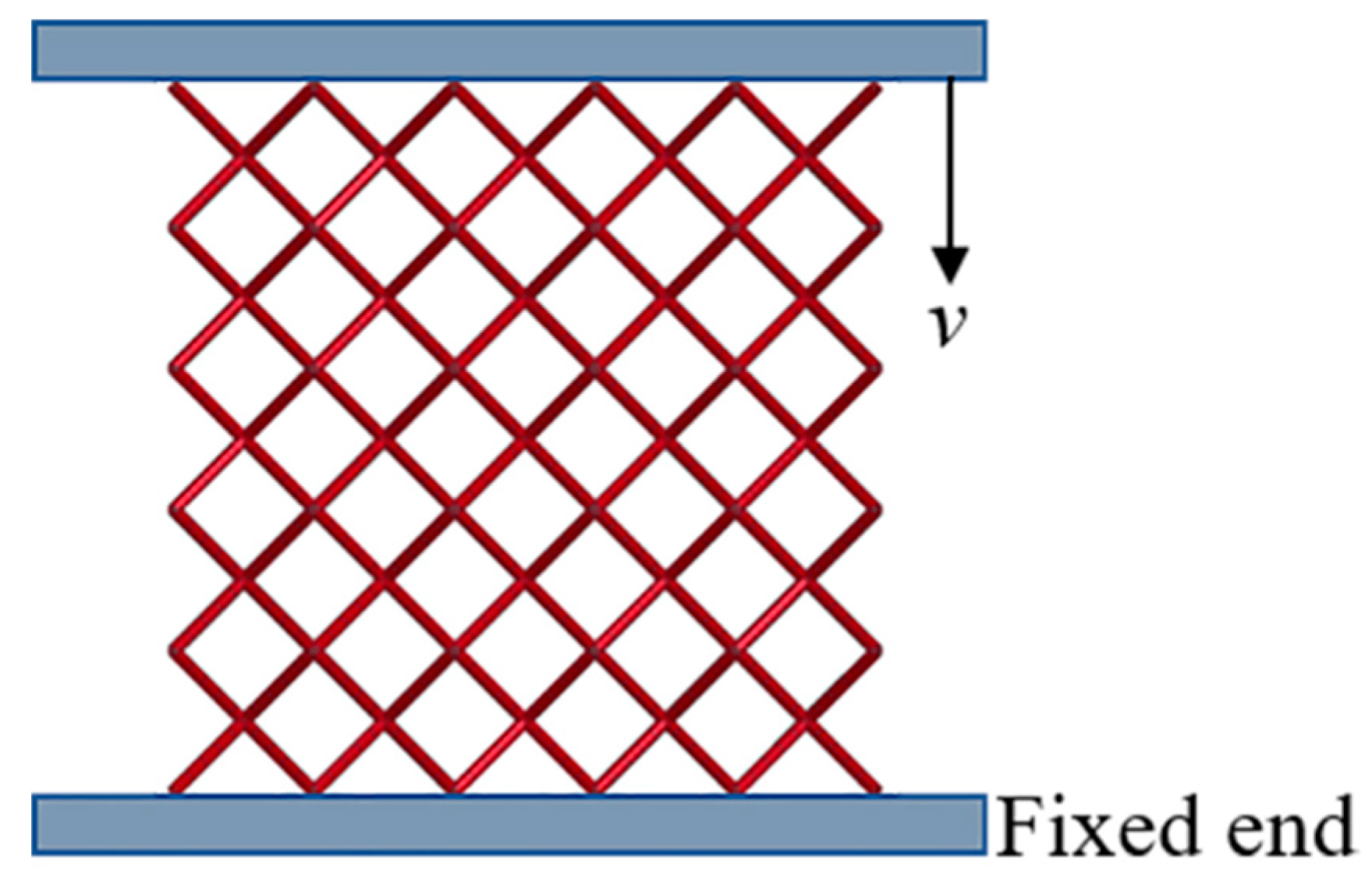
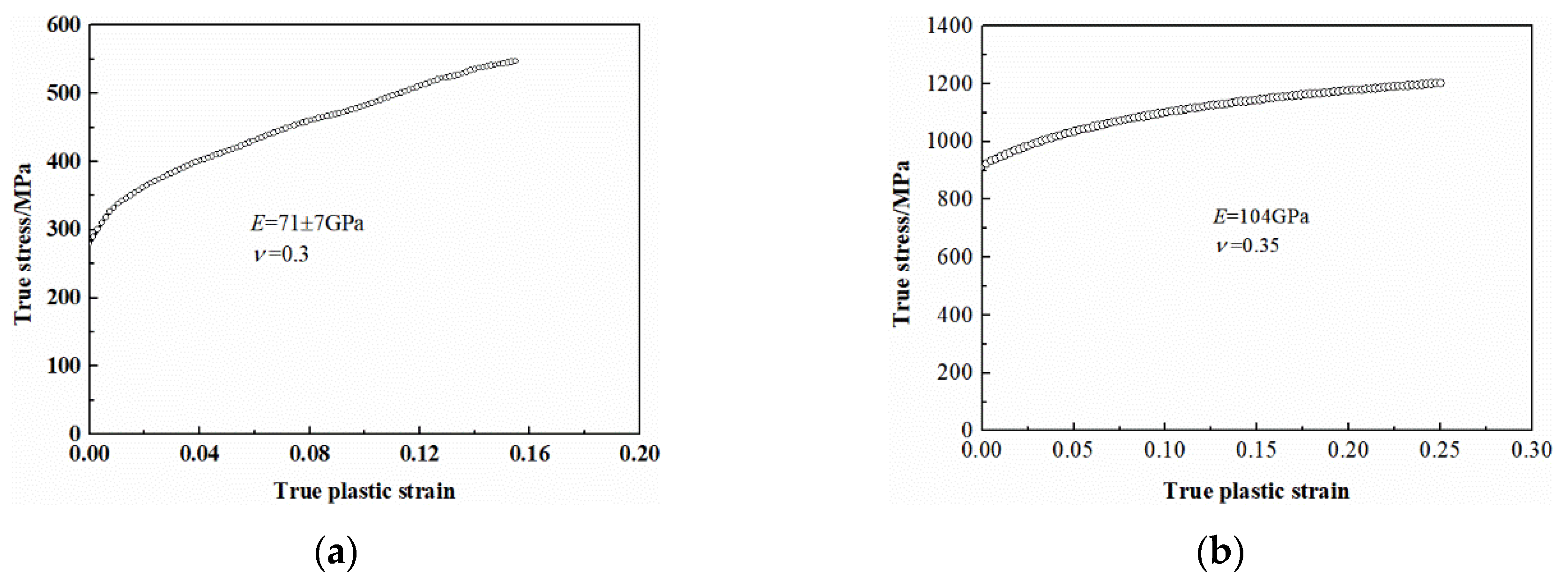
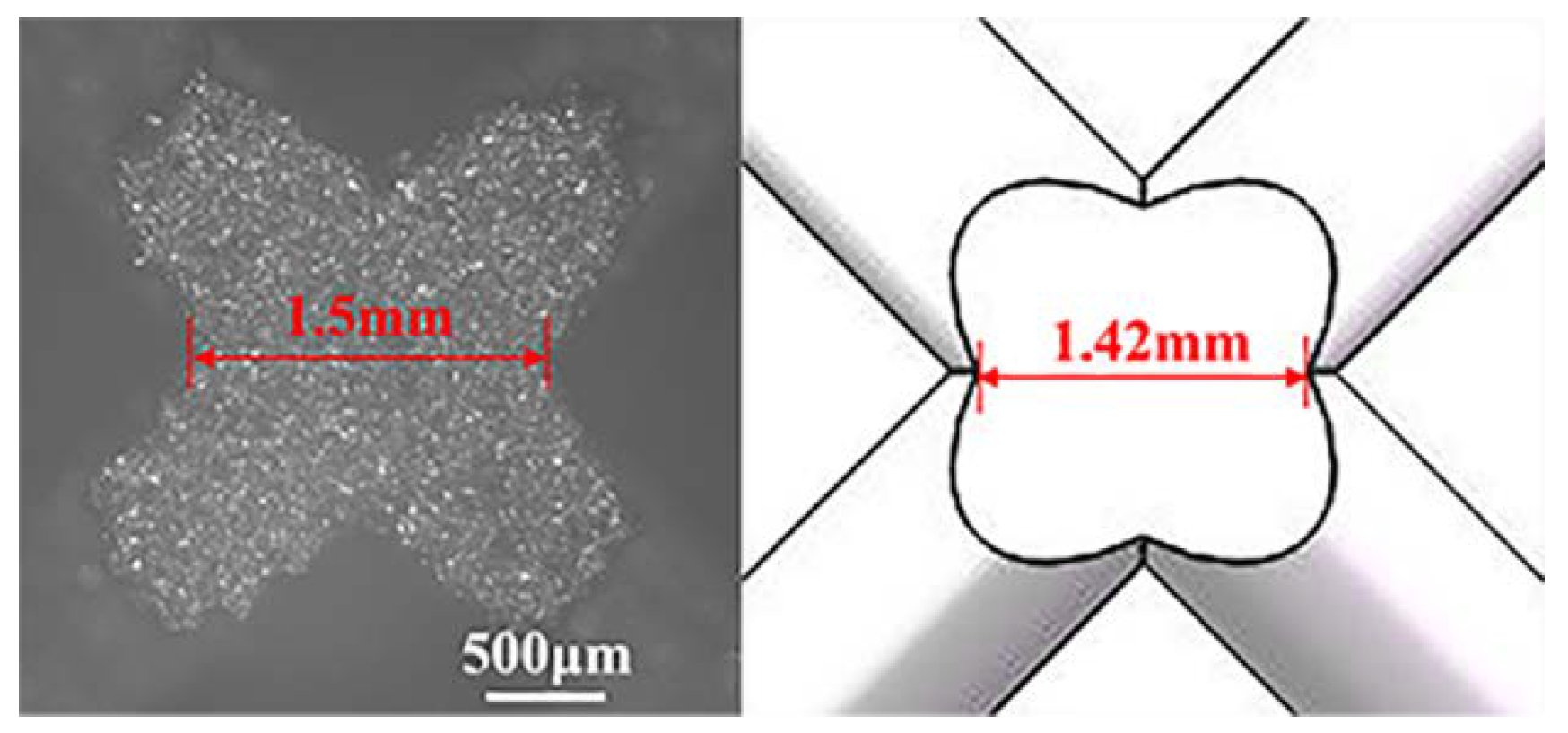
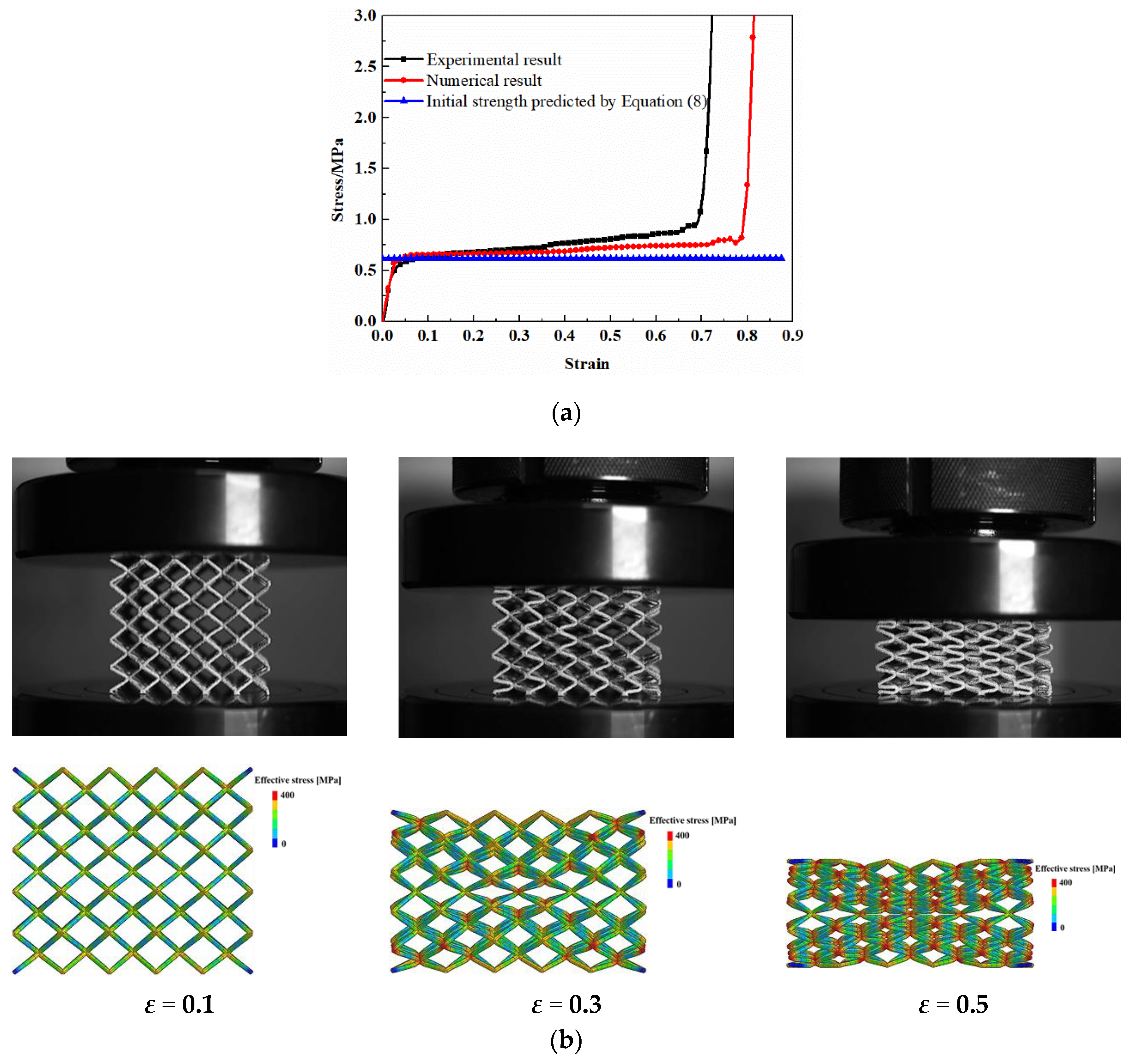
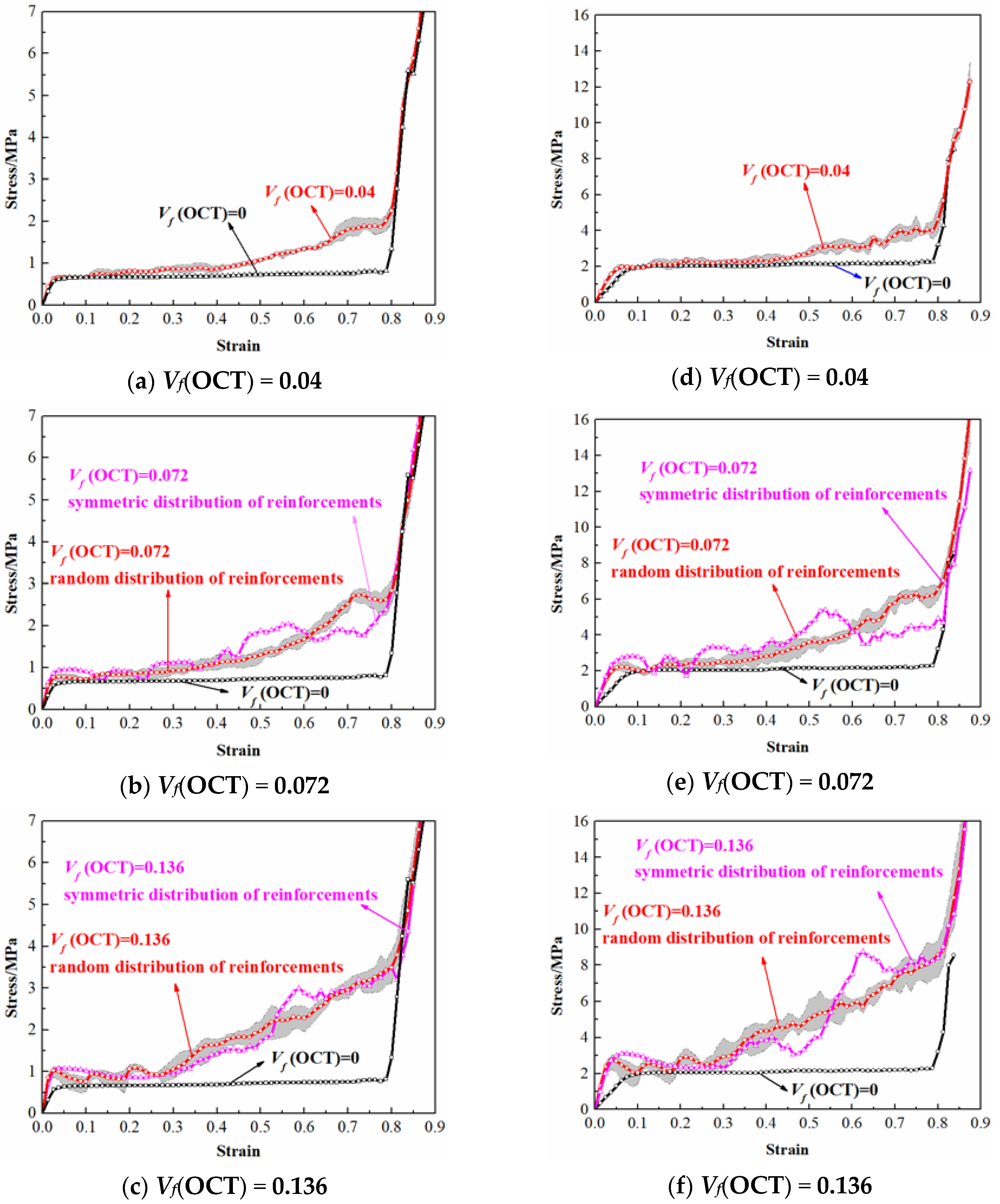


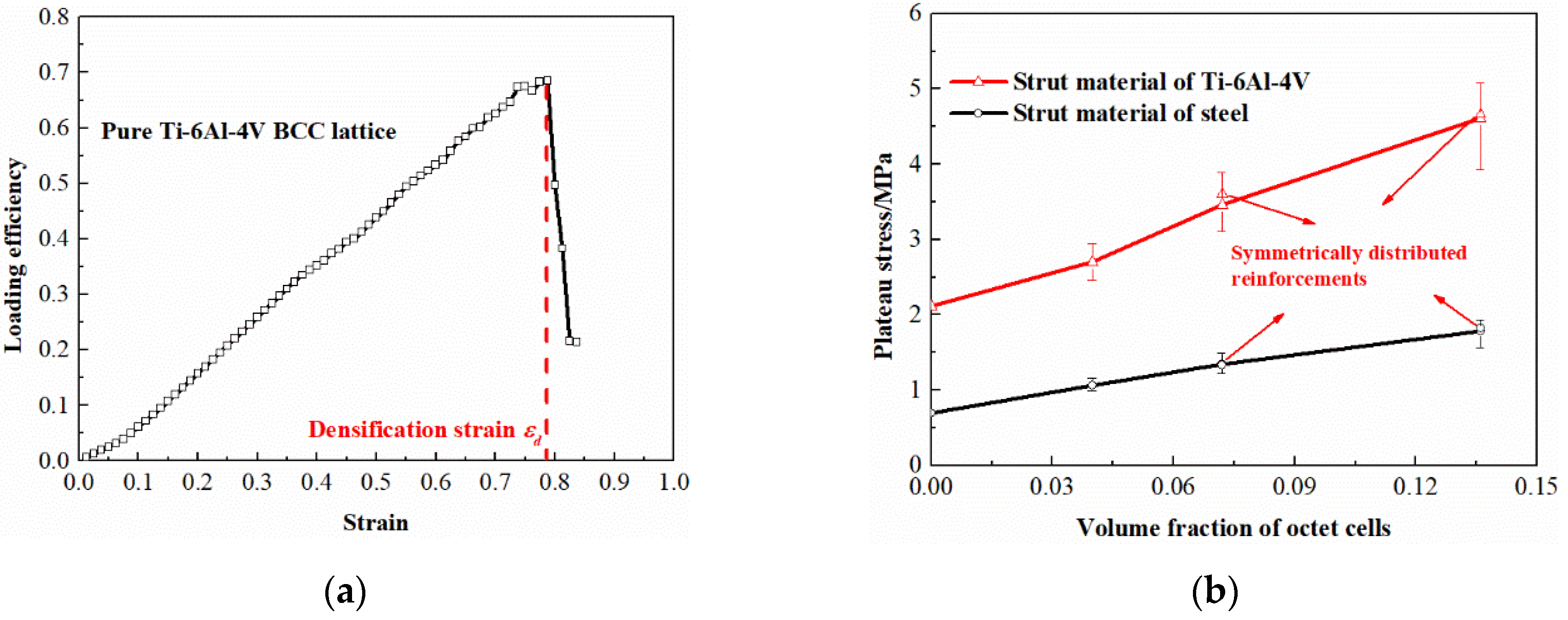
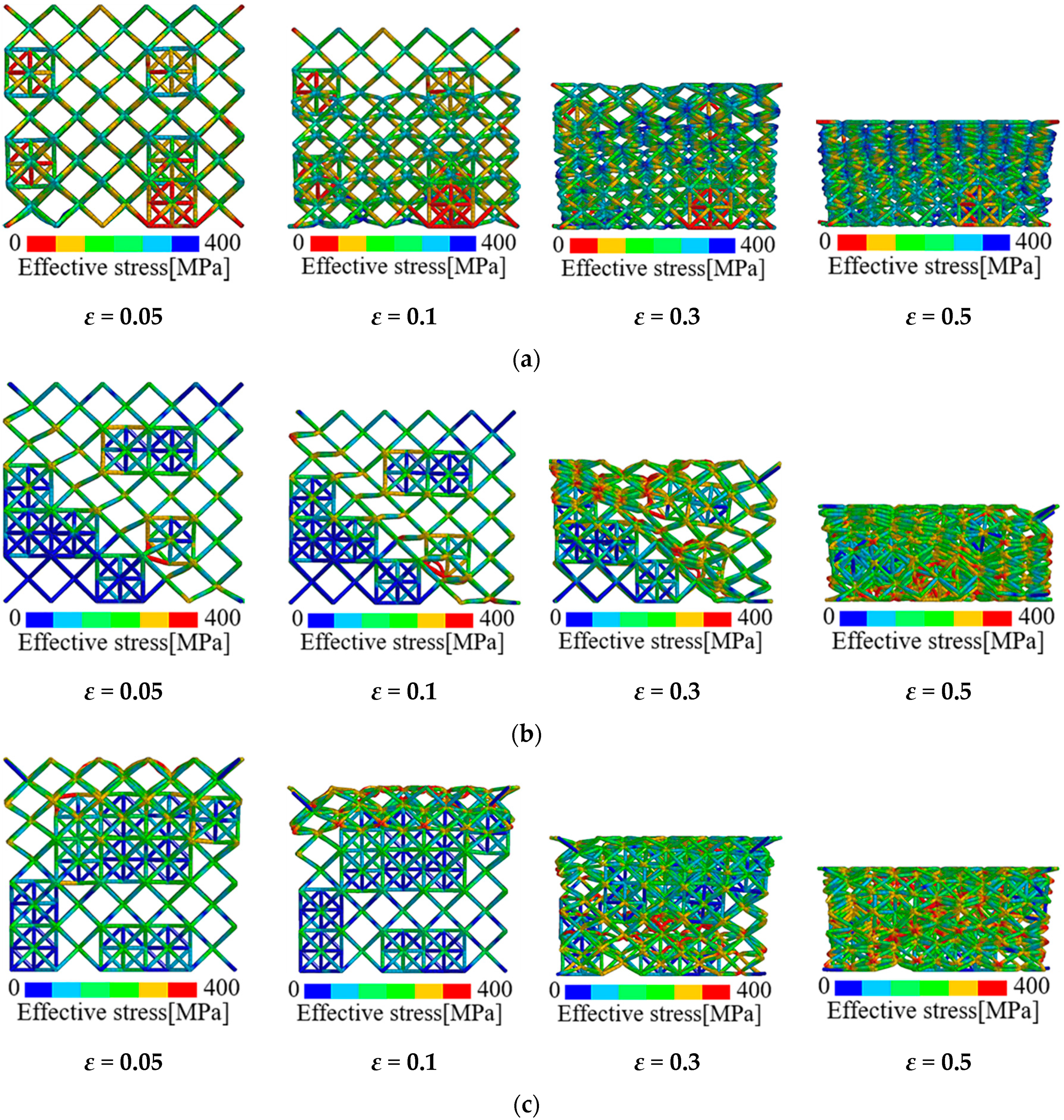

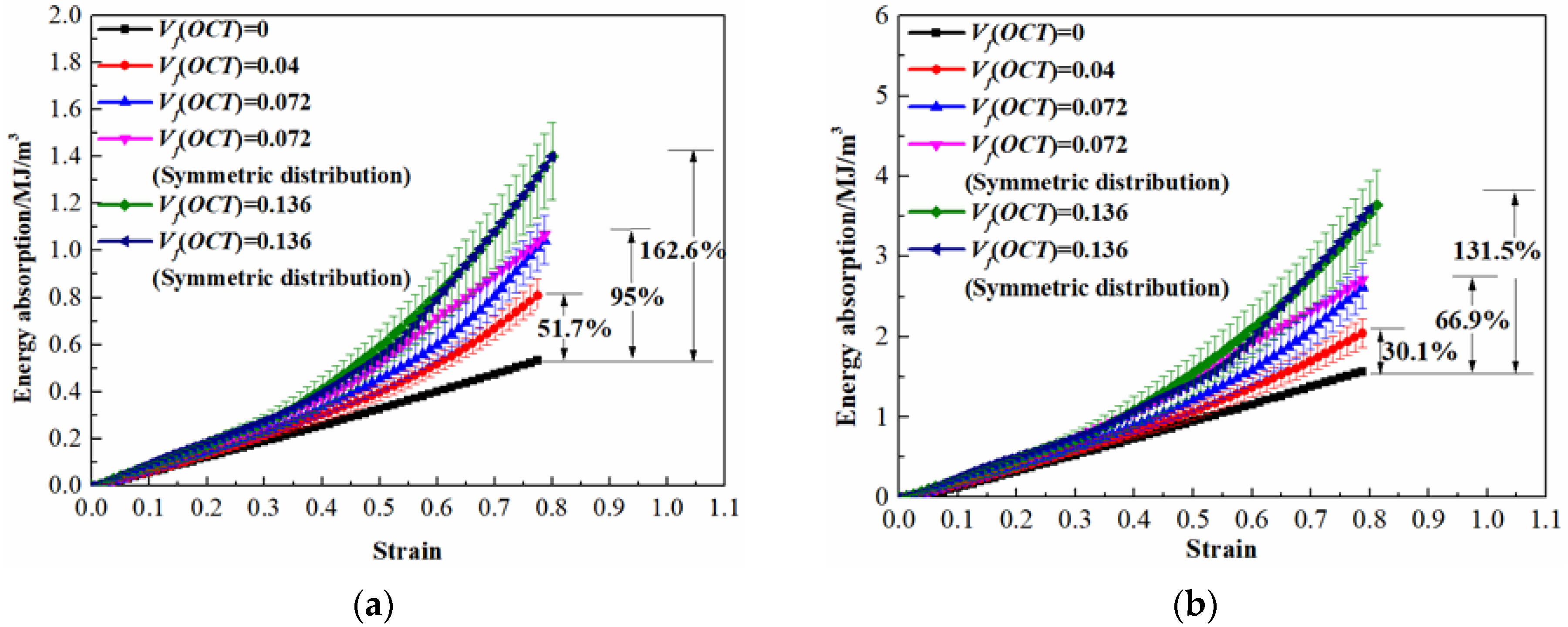
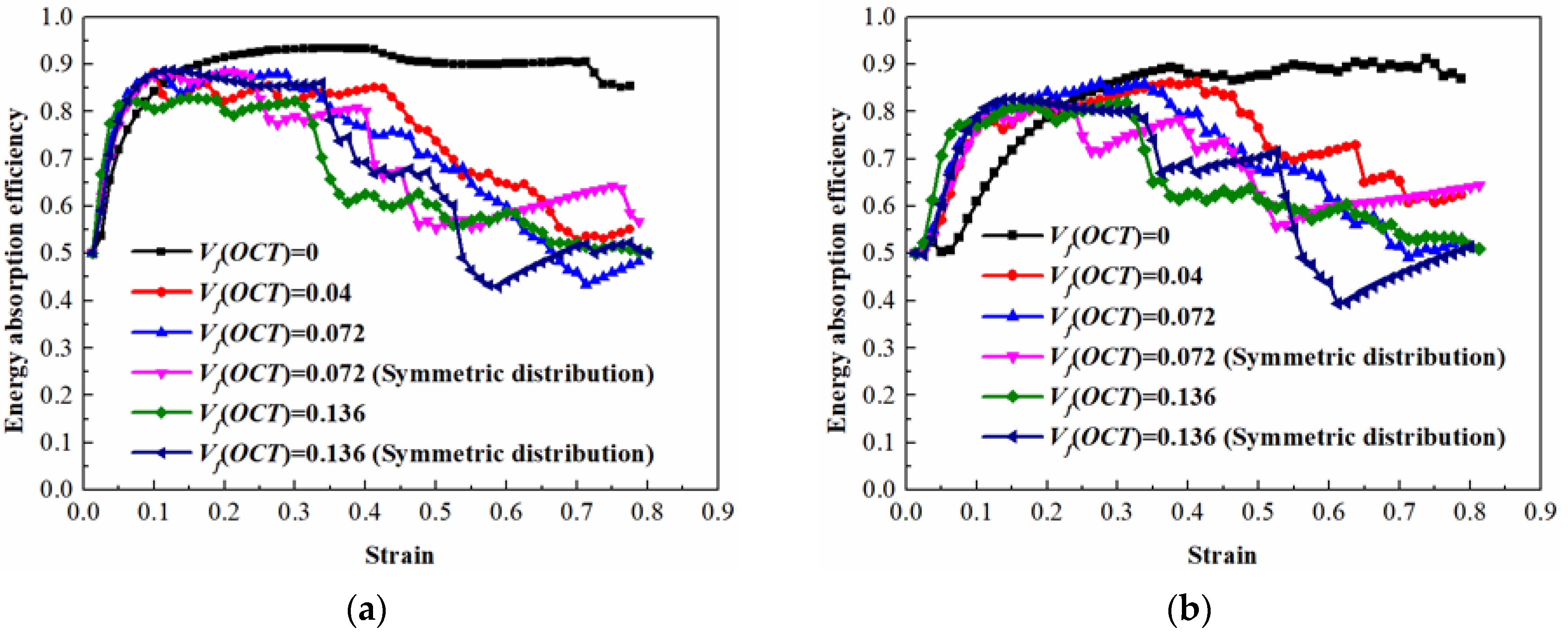
| Parameters | Dimension (mm × mm × mm) | Mass (g) | Struct Thickness (μm) | Relative Density |
|---|---|---|---|---|
| Designed value | 40 × 40 × 40 | 25.4 | 804 | 0.05 |
| Measured value | 40.36 × 40.32 × 40.52 | 27.8 | 830 | 0.053 |
© 2020 by the authors. Licensee MDPI, Basel, Switzerland. This article is an open access article distributed under the terms and conditions of the Creative Commons Attribution (CC BY) license (http://creativecommons.org/licenses/by/4.0/).
Share and Cite
Xiao, L.; Xu, X.; Song, W.; Hu, M. A Multi-Cell Hybrid Approach to Elevate the Energy Absorption of Micro-Lattice Materials. Materials 2020, 13, 4083. https://doi.org/10.3390/ma13184083
Xiao L, Xu X, Song W, Hu M. A Multi-Cell Hybrid Approach to Elevate the Energy Absorption of Micro-Lattice Materials. Materials. 2020; 13(18):4083. https://doi.org/10.3390/ma13184083
Chicago/Turabian StyleXiao, Lijun, Xiao Xu, Weidong Song, and Menglei Hu. 2020. "A Multi-Cell Hybrid Approach to Elevate the Energy Absorption of Micro-Lattice Materials" Materials 13, no. 18: 4083. https://doi.org/10.3390/ma13184083
APA StyleXiao, L., Xu, X., Song, W., & Hu, M. (2020). A Multi-Cell Hybrid Approach to Elevate the Energy Absorption of Micro-Lattice Materials. Materials, 13(18), 4083. https://doi.org/10.3390/ma13184083






